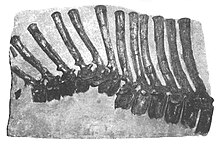Barsboldia
You can help expand this article with text translated from the corresponding article in Dutch. (July 2022) Click [show] for important translation instructions.
|
| Barsboldia Temporal range: Late Cretaceous,
| |
|---|---|

| |
| Sacrum of the holotype | |
| Scientific classification | |
| Domain: | Eukaryota |
| Kingdom: | Animalia |
| Phylum: | Chordata |
| Clade: | Dinosauria |
| Clade: | †Ornithischia |
| Clade: | †Neornithischia |
| Clade: | †Ornithopoda |
| Family: | †Hadrosauridae |
| Subfamily: | †Saurolophinae |
| Genus: | †Barsboldia Maryańska & Osmólska, 1981 |
| Type species | |
| †Barsboldia sicinskii Maryańska & Osmólska, 1981
| |
Barsboldia (meaning "of Barsbold", a well-known Mongolian paleontologist) is a genus of large hadrosaurid dinosaur from the early Maastrichtian Nemegt Formation of Ömnogöv', Mongolia. It is known from a partial vertebral column, partial pelvis, and some ribs.
Discovery
[edit]In 1970, a Polish-Mongolian expedition near the Nemegt found the skeleton of an ornithopod and first assigned it to Saurolophus angustirostris. However, two Polish paleontologists, Teresa Maryańska and Halszka Osmólska, came to the conclusion that it was a lambeosaurine that had to represent a separate species. They named and described Barsboldia sicinskii based on the holotype specimen ZPAL MgD-1/110. The genus name honors the Mongolian paleontologist Rinchen Barsbold, while the species name honors Wojciech Siciński, the technician at the Warsaw Paleobiological Institute who prepared the skeleton. The holotype specimen, found in a layer of the Nemegt Formation dating to the early Maastrichtian, consisted of a partial skeleton consisting of nine back vertebrae, nine hip vertebrae, fifteen tail vertebrae, a left ilium, parts of the left and right pubis, several ribs, and a few fragments of the hind limbs, with the backbone largely articulated. The anterior and posteriormost portions of the skeleton were lost due to erosion.[1]
Description
[edit]
Barsboldia was a large hadrosaur, previously measured 10 metres (33 ft) in length and 5 metric tons (5.5 short tons) in body mass.[2] In 2011, the tibial length was measured at 1.4 m (4.6 ft), rivaling that of Shantungosaurus measured at 1.47 m (4.8 ft) and that of Magnapaulia measured at 1.36 m (4.5 ft); this indicates that Barsboldia could have possibly reached within the range of 12–14 metres (39–46 ft) in total body length.[3] Similar to Ouranosaurus, the most distinctive features of Barsboldia are found in the neural spines. These are very tall, particularly over the hips, and were described as second only to those of Hypacrosaurus altispinus and the tips of those found in the first few vertebrae of the tail are club-shaped,[1] possibly a sign of old age.[4]
Phylogeny
[edit]Maryańska and Osmólska described their new genus as a lambeosaurine (or hollow-crested duckbill), the first from the Nemegt Formation, although it lacked a skull. However, the sacrum has a keel along the bottom, a possible lambeosaurine feature,[5] and the bones closely resemble those of Hypacrosaurus.[4][6] With only one partial skeleton known, and no skull, the genus has been considered dubious[5] or a possible lambeosaurine of uncertain placement.[7] A newer study published in 2011 suggests that Barsboldia is actually a valid saurolophine.[8]
The following cladogram was recovered in the 2011 phylogenetic analysis of Hadrosauroidea by Prieto-Márquez (the relationships within Lambeosaurinae and between basal hadrosauroids aren't shown).[8]


| |||||||||||||||||||||||||||||||||||||||||||||||||||||||||||||||||||||||||||||||||||||||||||
Paleobiology
[edit]As a hadrosaurid, Barsboldia would have been a large bipedal/quadrupedal herbivore, eating plants with a sophisticated skull that permitted a grinding motion analogous to chewing, and was furnished with hundreds of continually-replaced teeth. If it was a lambeosaurine, it would have had a hollow crest formed out of expanded skull bones containing the nasal passages, with a function relating to identification by sight and sound.[7]
See also
[edit]References
[edit]- ^ a b Maryańska, Teresa; Osmólska, Halszka (1981). "First lambeosaurine dinosaur from the Nemegt Formation, Upper Cretaceous, Mongolia". Acta Palaeontologica Polonica. 26: 243–255.
- ^ Paul, Gregory S. (2010). The Princeton Field Guide to Dinosaurs. New Jersey: Princeton University Press. p. 310.
- ^ Prieto-Márquez, A. (2011). "A Reappraisal of Barsboldia sicinskii (Dinosauria: Hadrosauridae) from the Late Cretaceous of Mongolia" (PDF). Journal of Paleontology. 83 (3): 468–477. Bibcode:2011JPal...85..468P. doi:10.1666/10-106.1. JSTOR 23020183.
- ^ a b Brett-Surman, Michael K. (1989). A revision of the Hadrosauridae (Reptilia: Ornithischia) and their evolution during the Campanian and Maastrichtian. Ph.D. dissertation. Washington, D.C.: Graduate School of Arts and Sciences of The George Washington University. pp. 1–272.
- ^ a b Norman, David B.; Sues, Hans-Dieter (2000). "Ornithopods from Kazakhstan, Mongolia and Siberia". In Benton, Michael J.; Shishkin, Mikhail A.; Unwin, David M.; Kurochkin, Evgenii N. (eds.). The Age of Dinosaurs in Russia and Mongolia. Cambridge: Cambridge University Press. pp. 462–479. ISBN 0-521-55476-4.
- ^ Glut, Donald F. (1997). "Barsboldia". Dinosaurs: The Encyclopedia. Jefferson, North Carolina: McFarland & Co. p. 202. ISBN 0-89950-917-7.
- ^ a b Horner, John R.; Weishampel, David B.; Forster, Catherine A. (2004). "Hadrosauridae". In Weishampel, David B.; Dodson, Peter; Osmólska, Halszka (eds.). The Dinosauria (2nd ed.). Berkeley: University of California Press. pp. 438–463. ISBN 0-520-24209-2.
- ^ a b Prieto-Márquez, Albert (2011). "A Reappraisal of Barsboldia sicinskii (Dinosauria: Hadrosauridae) from the Late Cretaceous of Mongolia". Journal of Paleontology. 83 (3): 468–477. Bibcode:2011JPal...85..468P. doi:10.1666/10-106.1. S2CID 83677586.

